BRK CO5120BN Handleiding
BRK
Rookmelder
CO5120BN
Bekijk gratis de handleiding van BRK CO5120BN (7 pagina’s), behorend tot de categorie Rookmelder. Deze gids werd als nuttig beoordeeld door 52 mensen en kreeg gemiddeld 4.5 sterren uit 26.5 reviews. Heb je een vraag over BRK CO5120BN of wil je andere gebruikers van dit product iets vragen? Stel een vraag
Pagina 1/7

1
THIS USER’S MANUAL HAS BEEN RESIZED TO PRINT OUT ON 8-1/2 x 11” PAGES.
BLACK page numbers reference the original printed document.
RED page numbers reference this web version.
Models CO5120BN,
CO5120PDBN
M08-0002-000 Q10/02
IMPORTANT! PLEASE READ CAREFULLY AND SAVE.
This user’s manual contains important information about your CO Alarm’s
operation. If you are installing this CO Alarm for use by others, you must
leave this manual—or a copy of it—with the end user.
USER’S MANUAL
AC POWERED CARBON
MONOXIDE ALARM
WITH BATTERY BACK-UP
Model CO5120BN
AC POWERED CARBON
MONOXIDE ALARM
WITH BATTERY BACK-UP
AND DIGITAL DISPLAY
Model CO5120PDBN
120VAC ~, 60Hz, 0.09A
TABLE OF CONTENTS
Introduction . . . . . . . . . . . . . . . . . . . . . . . . . . . . . . . . . . . . . . . . . . . . . . .1-2
Basic Safety Information . . . . . . . . . . . . . . . . . . . . . . . . . . . . . . . . . . . .1
How Your CO Alarm Works . . . . . . . . . . . . . . . . . . . . . . . . . . . . . . . .1-2
Understanding the Light and Horn Patterns . . . . . . . . . . . . . . . . . . . .1-2
Installation . . . . . . . . . . . . . . . . . . . . . . . . . . . . . . . . . . . . . . . . . . . . .2-4/2-3
Where to Install CO Alarms . . . . . . . . . . . . . . . . . . . . . . . . . . . . . . . . . .2
Where CO Alarms Should NOT Be Installed . . . . . . . . . . . . . . . . . . . . .2
How to Install Your CO Alarm . . . . . . . . . . . . . . . . . . . . . . . . . . . . .3-4/3
Using the Optional Locking Features . . . . . . . . . . . . . . . . . . . . . . . . . .3-4/4
The Battery Compartment Lock . . . . . . . . . . . . . . . . . . . . . . . . . . . . .3/4
The Mounting Bracket Lock . . . . . . . . . . . . . . . . . . . . . . . . . . . . . . . . .4
If Your CO Alarm Sounds . . . . . . . . . . . . . . . . . . . . . . . . . . . . . . . . . . . . . . .5
If the Alarm Sounds . . . . . . . . . . . . . . . . . . . . . . . . . . . . . . . . . . . . . . .5
Using the Silence Feature . . . . . . . . . . . . . . . . . . . . . . . . . . . . . . . . . . .5
The Latching Alarm Indicator . . . . . . . . . . . . . . . . . . . . . . . . . . . . . . . .5
Weekly Testing . . . . . . . . . . . . . . . . . . . . . . . . . . . . . . . . . . . . . . . . . . . . . . .5
Regular Maintenance . . . . . . . . . . . . . . . . . . . . . . . . . . . . . . . . . . . . . . . . . .5
Replacing the Battery . . . . . . . . . . . . . . . . . . . . . . . . . . . . . . . . . . . . . .5
What You Need To Know About CO . . . . . . . . . . . . . . . . . . . . . . . . . . .6-7/6
What is CO? . . . . . . . . . . . . . . . . . . . . . . . . . . . . . . . . . . . . . . . . . . . . .6
Symptoms of CO Poisoning . . . . . . . . . . . . . . . . . . . . . . . . . . . . . . . . .6
Finding the Source of CO After an Alarm . . . . . . . . . . . . . . . . . . . . . . .6
Potential Sources of CO in the Home . . . . . . . . . . . . . . . . . . . . . . . . . .6
How Can I Protect My Family? . . . . . . . . . . . . . . . . . . . . . . . . . . . . .7/6
Underwriters Laboratories, Inc. UL2034 . . . . . . . . . . . . . . . . . . . . . . . . .7/6
General Limitations Of CO Alarms . . . . . . . . . . . . . . . . . . . . . . . . . . . .6-7/7
Troubleshooting Guide . . . . . . . . . . . . . . . . . . . . . . . . . . . . . . . . . . . . .6-7/7
Limited Warranty . . . . . . . . . . . . . . . . . . . . . . . . . . . . . . . . . . . . . . . . . .6-7/7
All Rights Reserved. © 2002 BRK Brands, Inc.
BRK Brands, Inc., 3901 Liberty Street Road, Aurora, IL 60504-8122
Consumer Affairs: (800) 323-9005 www.brkelectronics.com•
INTRODUCTION
BASIC SAFETY INFORMATION
• Dangers, Warnings, and Cautions alert you to important operating instructions or to potentially
hazardous situations. Pay special attention to these items.
• THIS IS NOT A SMOKE ALARM! This CO Alarm is designed to detect carbon monoxide from ANY
source of combustion. It is NOT designed to detect smoke, fire, or any other gas.
• This CO Alarm is approved for use in single-family residences. It is NOT designed for marine or RV
use.
•
This CO Alarm will only indicate the presence of carbon monoxide gas at the sensor. Carbon monoxide
gas may be present in other areas.
• This unit does not work without power. If the AC power fails, the battery back-up will power the
alarm for at least 7 days provided the 9V battery is fresh and correctly installed.
• The Silence Feature is for your convenience only and will not correct a CO problem. Always check
your home for a potential problem after any alarm. Failure to do so can result in injury or death.
• This CO Alarm should receive continuous 120VAC, 60 Hz, pure sine wave electrical power. (The
battery is meant for emergency back-up only). Do not use in an extension cord or outlet controlled
by a dimmer or switch. In order for the emergency battery back-up to work, a working (fresh) bat-
tery must be properly installed.
•
NEVER ignore any alarm. See If Your CO Alarm Sounds for more information on how to respond to“ ”
an alarm. Failure to respond can result in injury or death.
• Test this Carbon Monoxide Alarm once a week. If it ever fails to test correctly, have it replaced
immediately! If the CO Alarm is not working properly, it cannot alert you to a problem.
• This product is intended for use in ordinary indoor locations of family living units. It is not designed
to measure CO levels in compliance with Occupational Safety and Health Administration (OSHA)
commercial or industrial standards. Individuals with medical conditions that may make them more
sensitive to carbon monoxide may consider using warning devices which provide audible and visu-
al signals for carbon monoxide concentrations under 30 ppm. For additional information on carbon
monoxide and your medical condition contact your physician.
HOW YOUR CO ALARM WORKS
The Cover Of Your CO Alarm
2
1
5
3
4
1. Test/Silence Button
Scroll Button (CO5120PDBN)
2. POWER/ALARM Light (RED)
3. Air Vents
4. (Behind the Cover) Alarm Horn:
85dB audible alarm for test,
alarm, and unit malfunction
warning.
5. Digital Display (CO5120PDBN)
UNDERSTANDING THE LIGHT AND HORN PATTERNS (CO5120BN)
Condition LED (Red Light) Horn
POWER UP LED flashes on once, Horn “chirps”
then shines continuously once.
DURING TESTING LED flashes once every second Horn pattern:
during the test cycle 4 beeps, pause,
4 beeps, pause
LOW OR MISSING LED flashes once a minute Horn “chirps”
BATTERY once a minute
MISSING OR DEAD LED is OFF Horn is silent
BATTERY (DC back-
up disabled
WARNING: When the AC power is Off, if the battery is dead or missing, the
CO Alarm cannot work.

2
UNDERSTANDING THE LIGHT AND HORN PATTERNS (CO5120BN), Continued
Condition LED (Red Light) Horn
ALARM CONDITION LED flashes once every second Horn pattern:
Single CO Alarm 4 beeps, pause,
(not interconnected) 4 beeps, pause,
repeating
ALARM CONDITION LED flashes rapidly on the units Horn pattern:
Interconnected that triggered the alarm. LEDs 4 beeps, pause,
Series of CO Alarms on the other Alarms in the series repeating on all
will not flash CO Alarms
IN SILENCE MODE LED flashes once every second Horn stays quiet
on initiating Alarm for 4 minutes
“LATCHING” ALARM LED Flashes once every Horn stays quiet
INDICATOR 5 seconds
MALFUNCTION LED flashes 3 times Horn sounds
synchronized with 3 rapid chirps 3 rapid chirps
(chirp-chirp-chirp)
every minute
DISPLAY CONDITIONS (CO5120PDBN)
Alarm operating on AC
power
Alarm operating on
emergency battery
back-up
Low / missing battery
warning
“ ”Err Alarm is not
operating properly
What you see and hear if CO is detected:
PRE-ALARM LEVELS :
HORN: Silent
DISPLAY: Shows CO levels detected in ppm
(CO5120PDBN)
POWER/ALARM LIGHT: On continuously
ALARM LEVELS OF CO ARE DETECTED:
HORN: Sounds loudly - 4 beeps, pause, 4 beeps,
pause. This sequence repeats for as long as the
unit is in alarm*
DISPLAY: Shows CO levels detected in ppm
(CO5120PDBN)
POWER/ALARM LIGHT: Flashes rapidly
*Note: If unit goes into alarm under battery back-
up power, the regular 4 beeps-brief pause cycle
will repeat for four minutes. After four minutes, the
pause will increase to 1 minute.
IF YOU SILENCE THE ALARM:
HORN: Silent for about 4 minutes*
DISPLAY: Shows CO levels detected in ppm
(CO5120PDBN)
POWER/ALARM LIGHT: Flashes rapidly
*Note: After 4 minutes, if CO levels drop below
alarm levels, the unit will remain silent and return
to normal operation. If CO present still indicates a
potentially dangerous situation, the horn will
sound again.
IF THE CO LEVELS RETURN TO NORMAL:
HORN: Silent
DISPLAY: Dash lit by “READY” (CO5120PDBN)
POWER/ALARM LIGHT: Shines continuously
SMART INTERCONNECT FEATURE
This CO Alarm includes Smart Interconnect which enables the Alarm to be interconnected with other BRK“ ”
Smoke and CO Alarms. When interconnected to Smoke Alarms that go into alarm, this CO Alarm will sound the
smoke horn pattern.
USING THE PEAK CO MEMORY (CO5120PDBN)
The CO Memory Feature lets you check the highest level of CO recorded during an alarm.
To check CO Memory:
1. Press and release the Test/Silence/Scroll button until the dash scrolls to “MEMORY”.
2. Press and hold Test/Silence/Scroll button to display Memory CO level.
To clear CO Memory:
1. Press and release the Test/Silence/Scroll button until the dash scrolls to “CLEAR MEMORY.”
2. Press and hold the Test/Silence/Scroll button until the display shows “CLr.”
NOTE: The highest CO level will be saved, even after a power interruption, until you clear it. DO NOT clear the
CO Memory reading if you plan to call someone to investigate a CO problem! Clear the CO Memory reading
only after the investigator has checked your home.
INSTALLATION
WHERE TO INSTALL CO ALARMS
The National Fire Protection Association (NFPA) recommends that a CO Alarm should be centrally located out-
side of each separate sleeping area in the immediate vicinity of the bedrooms. For added protection, install
additional CO Alarms in each separate bedroom, and on every level of your home.
If your bedroom hallway is longer than 40 feet (12 meters), install a CO Alarm at BOTH ends of the hallway.
In a Single-level Home:
• Install at least one CO Alarm near or within each separate sleeping area.
•
For added protection, install an additional CO Alarm at least 20 feet (6 meters), away from the furnace or
fuel burning heat source.
In a Multi-level Home (same as above plus):–
• Install at least one CO Alarm near or within each separate sleeping area.
• For added protection, install at least one CO Alarm on each level of the home. If you have a basement,
install that CO Alarm at the top of the basement stairs.
• For added protection, install an additional CO Alarm at least 20 feet (6 meters) away from the furnace or
fuel burning heat source.
GARAGE
SUGGESTED AREAS FOR INSTALLING ADDITIONAL CO ALARMS
BEDROOM
BEDROOM
HALL
LIVING ROOM
KITCHEN
BASEMENT
BEDROOM
REQUIRED TO MEET NFPA RECOMMENDATIONS
WHERE CO ALARMS SHOULD NOT BE INSTALLED
DO NOT locate this CO Alarm:
•In garages, kitchens, furnace rooms, or in any extremely dusty, dirty or greasy areas.
•Where combustion particles are produced. Combustion particles form when something burns. Areas to
avoid include poorly ventilated kitchens, garages, and furnace rooms. Keep units at least 20 feet (6 meters)
from the sources of combustion particles (stove, furnace, water heater, space heater) if possible. In areas
where a 20-foot distance is not possible – in modular, mobile, or smaller homes, for example it is recom-–
mended the CO Alarm be placed as far from these fuel-burning sources as possible. The placement recom-
mendations are intended to keep these Alarms at a reasonable distance from a fuel-burning source, and
thus reduce or “unwanted” “nuisance” alarms. Unwanted alarms can occur if a CO Alarm is placed directly
next to a fuel-burning source. Ventilate these areas as much as possible.
•Within 5 feet (1.5 meter) of any cooking appliance.
•In extremely humid areas. This Alarm should be at least 10 feet (3 meter) from a bath or shower, sauna,
humidifier, vaporizer, dishwasher, laundry room, utility room or other source of high humidity.
•In areas where temperature is colder than 40˚F (4 C) or hotter than 100 F (38 C). These areas include non-˚ ˚ ˚
airconditioned crawl spaces, unfinished attics, uninsulated or poorly insulated ceilings, porches, and
garages.
•In turbulent air, like near ceiling fans, heat vents, air conditioners, fresh air returns, or open windows.
Blowing air may prevent CO from reaching the sensors.
•In direct sunlight.
• This CO Alarm is designed for use inside a single-family home or apartment. It is not meant to be
used in common lobbies, hallways, or basements of multi-family buildings unless working CO
Alarms are also installed in each family living unit. CO Alarms in common areas may not be heard
from inside individual family living units.
• This CO Alarm alone is not a suitable substitute for complete detection systems in places which
house many people, like hotels or dormitories, unless a CO Alarm is also placed in each unit.
• DO NOT use this CO Alarm in warehouses, industrial or commercial buildings, special-purpose
non-residential buildings, RVs, boats, or airplanes. This CO Alarm is specifically designed for
residential use, and may not provide adequate protection in non-residential applications.

3
BEFORE YOU BEGIN INSTALLATION
This unit is designed to be mounted on any standard wiring junction box up to a 4-inch size, on either the ceil-
ing or wall. Read Where to Install CO Alarms Where Not To Install CO Alarms before you begin installa-“ ” and “ ”
tion. If a junction box is not already in place, install one using standard #12 or #14 gauge copper wire.
This Alarm must have AC or battery power to operate. If the AC power fails, the battery back-up will
power the Alarm for a short time if the 9V battery is fresh and correctly installed. If AC power fails, and
the battery is dead or missing, the Alarm cannot operate.
Find the pair of self-adhesive labels included with this CO Alarm.
• On each label write in the phone number of your emergency responder (like 911) and a qualified appliance
technician.
• “ Place one label near the CO Alarm, and the other label in the fresh air location you plan to go if the”
alarm sounds.
NOTE: A qualified appliance technician is defined as “a person, firm, corporation, or company that either in person
or through a representative, is engaged in and responsible for the installation, testing, servicing, or replacement of
heating, ventilation, air conditioning (HVAC) equipment, combustion appliances and equipment, and/or gas fire-
places or other decorative combustion equipment.”
PARTS OF THIS CO ALARM
1 Mounting Bracket
2 Mounting Slot and Screw*
3 Locking Pins (break out of
bracket)
4 Hot (Black) AC Wire
5 Neutral (White) AC Wire
6 Interconnect Wire (Orange)
7 Lever to Open Battery
Compartment
8 Swing-Out Battery
Compartment
9 Quick-Connect Power
*Not Included
1
2
3
2
9
8
7
3
5
6
4
HOW TO INSTALL YOUR CO ALARM
INSTALLATION, continued
Tools you will need: Standard/Flathead screwdriver.
ELECTRICAL SHOCK HAZARD. Turn off power to the area where you will install this unit at the circuit
breaker or fuse box before beginning installation. Failure to turn off the power before installation may result
in serious electrical shock, injury or death.
To install this unit:
1. Remove the mounting bracket from the base. Position the screw slots on the mounting bracket over the
screws in the junction box. Tighten the screws.
2. Using wire nuts, connect the power connector to the AC power.
3. Plug the power connector into the back of the CO Alarm.
4. Position the base of the Alarm over the mounting bracket and turn. The Alarm can be positioned over the
bracket every 60°. Turn the unit clockwise (right) until the unit is in place.
5. Check all connections.
STAND ALONE ALARM ONLY:
•Connect the white wire on the power connector to the neutral wire in the junction box.
•Connect the black wire on the power connector to the hot wire in the junction box.
•Tuck the orange wire inside the junction box.
It is used for interconnect only.
INTERCONNECTED ALARMS ONLY:
Strip off about 1/2 of the plastic coating on the orange interconnect wire on the power connector.”
•Connect the white wire on the power connector to the neutral wire (usually white) in the junction box.
•Connect the black wire on the power connector to the hot wire (usually black) in the junction box.
•Connect the orange wire on the power connector to the interconnect wire in the junction box. Repeat for
each unit you are interconnecting. Never connect the hot or neutral wires in the junction box to the orange
interconnect wire.
STAND ALONE ALARM ONLY:
•If you are only installing one unit, restore power to the junction box.
INTERCONNECTED ALARMS ONLY:
•If you are interconnecting multiple Alarms, repeat Step 1-5 for each Alarm in the series. When you
are finished, restore power to the junction box.
ELECTRICAL SHOCK HAZARD. Do not restore power until all Alarms are completely installed. Restoring
power before installation is complete may result in serious electrical shock, injury or death.
SPECIAL REQUIREMENTS FOR INTERCONNECTED CO ALARMS
•
Failure to meet any of the above requirements could damage the units and cause them to mal-
function, removing your protection.
• AC and AC/DC CO Alarms can be interconnected. Under AC power, all units will alarm when one
senses CO. When power is interrupted, only the AC/DC units in the series will continue to send
and receive signals. AC powered CO Alarms will not operate.
Interconnected units can provide earlier warning of a CO problem than stand-alone units, especially if the prob-
lem starts in a remote area of the dwelling. If any unit in the series senses CO, all units will alarm. To determine
which CO Alarm initiated an alarm, refer to the table.
On Initiating CO Alarm Red LED Flashes Once per Second
On All Other CO Alarms Red LED Does Not Flash Once per Second
Interconnect units within a single family residence only. Otherwise all households will experience unwanted
alarms when you test any unit in the series. Interconnected units will only work if they are wired to compatible
units and all requirements are met.
This unit is designed to be compatible with: BRK Electronics
®
Smoke Alarm
Models SC6120B, 4120, 4120B, 4120SB, 4919, 2002RAC, 100S, 5919, 5919TH; BRK Electronics
®
Heat Alarm
Models HD6135F, HD6135FB; BRK Electronics
®
CO Alarm Models SC6120B, CO5120BN, CO5120PDBN; and
First Alert
®
Smoke Alarm Models SA4120B, SA4121B, SA4919B, SA100B.
Interconnected units must meet ALL of the following requirements:
• A maximum of 18 compatible BRK Electronics® Smoke, Heat or CO Alarms may be interconnected. No
more than 12 of the 18 can be Smoke Alarms per NFPA 72.
• The same fuse or circuit breaker must power all interconnected units.
• The total length of wire interconnecting the units should be less than 1000 feet. The interconnect wire
should be Type 18 gauge AWM or larger, rated at least 300V. If an interconnect wire is not already part of
your household wiring, you will need to install one. This type of wire is commonly available at Hardware
and Electrical Supply stores.
• All wiring must conform to all local electrical codes and Article 760 of the National Electrical Code. Refer
to NFPA, Chapter 2 and/or your local building code for further connection requirements.
6.
Make sure the CO Alarm is receiving AC power. Under normal operation,the red indicator light will shine continu-
ously.
If the red power indicator light does not light, TURN OFF POWER TO THE JUNCTION BOX and
recheck all connections. If all connections are correct and the red power indicator still does not light when
you restore the power, the unit should be replaced immediately.
7. ACTIVATING THE BATTERY BACK-UP
Activate the battery back-up by removing the Pull to Activate Battery Back-Up tab. You do not need to“ ”
open the battery compartment and reposition the battery during installation.
DO NOT remove the battery
activation tab until AC power is turned on to conserve battery power.
8. Test the CO Alarm. Press and hold the test button on the cover until the alarm sounds: 4 beeps, pause,
4 beeps, pause. In a series of interconnected Alarms, you must test each Alarm separately by pressing and
holding the test button. Make sure all units alarm when each one is tested.
If any unit in the series does not alarm during testing, TURN OFF POWER and recheck connections. If it does not
alarm when you restore power, replace it immediately.
6
7
8
4
3
1
5
4
3
1
5
2
A B
}}
A. Unswitched 120VAC 60 Hz source B. To Additional Alarms, Maximum = 18 Alarms
1. CO Alarm
2. Ceiling or Wall
3. Power Connector
4. Wire Nut
5. Junction Box
6. Neutral Wire (White)
7. Interconnect Wire (Orange)
8. Hot Wire (Black)
Product specificaties
| Merk: | BRK |
| Categorie: | Rookmelder |
| Model: | CO5120BN |
Heb je hulp nodig?
Als je hulp nodig hebt met BRK CO5120BN stel dan hieronder een vraag en andere gebruikers zullen je antwoorden
Handleiding Rookmelder BRK

7 Juli 2023

10 Mei 2023

10 Mei 2023

10 Mei 2023

10 Mei 2023

20 April 2023

29 Maart 2023

24 Maart 2023

21 Februari 2023

7 Februari 2023
Handleiding Rookmelder
- Meross
- Inovonics
- Steren
- Fibaro
- CodeRED
- KlikaanKlikuit
- Lanberg
- Swann
- Fito Profi-line
- EVE
- DSC
- GEV
- Pristine
- Elro
- BRK DICON
Nieuwste handleidingen voor Rookmelder
27 Juli 2025
9 Juli 2025
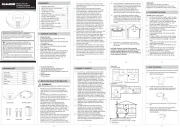
4 Juli 2025
4 Juli 2025

1 Juli 2025
11 Juni 2025

8 Juni 2025
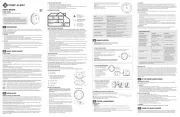
8 Juni 2025
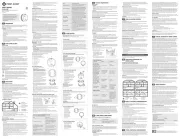
8 Juni 2025

30 Mei 2025